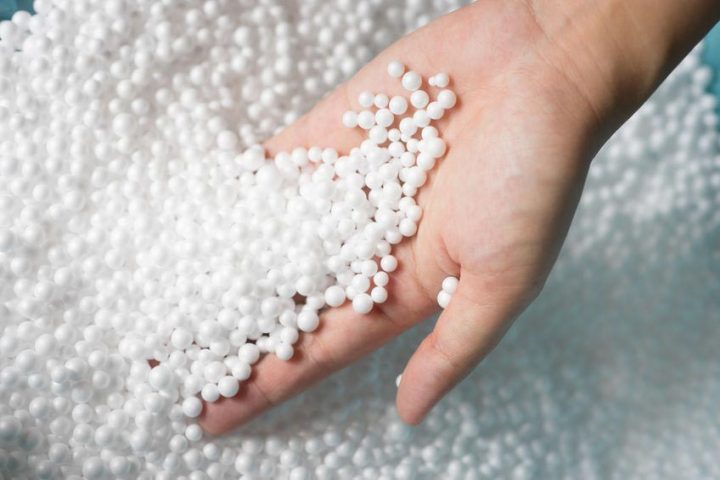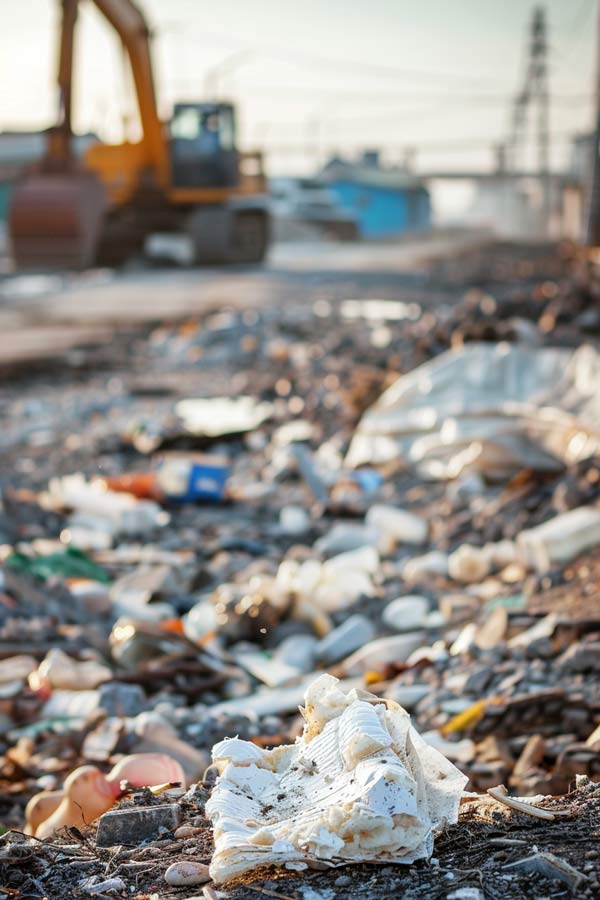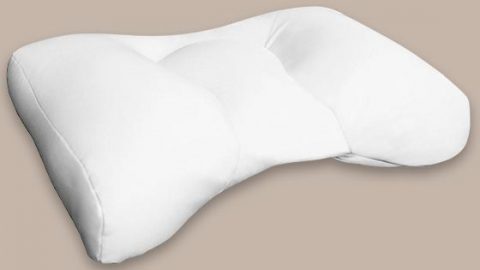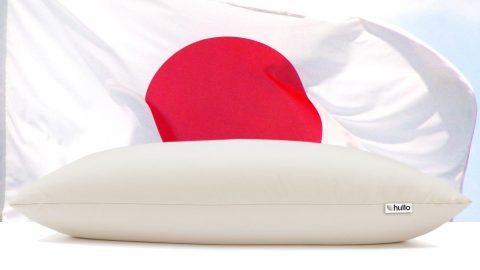
A handful of clouds… err… microbeads
Have you seen those late-night microbead pillow informercials?
Recently I overheard an exceedingly optimistic narrator on television say:
“A pillow 300 years in the making, based on the traditional Asian buckwheat pillow.”
The pillow that flashed on screen was filled with so-called microbeads. But it’s based on the buckwheat pillow?
I started a buckwheat pillow company many years ago, so I couldn’t resist ordering one of these things to see what the hell it was.
I went shopping online and noticed that some of the popular microbead pillows used the term “sobakawa,” which is japanese for “buckwheat,” in in their product descriptions, even though they aren’t genuine sobakawa pillows.
Buckwheat hulls (the hard outer shells that protect the buckwheat plant’s seeds) have been used as pillow filling for hundreds of years. Buckwheat hulls and microbeads are similar in that the individual pieces of filling are each approximately 3-4 mm in diameter. These tiny pieces work together allowing your pillow to be:
- moldable and supportive. You can shift the pillow’s fill to conform to the shape of your head and neck providing even and comfortable support.
- breathable and cool, retaining no heat. The space between the pieces of fill promote airflow, which keeps your head cool at night.
You could call microbeads a synthetic alternative to buckwheat hulls, but it’s a bit deceptive to use the term “sobakawa” to describe a microbead product that contains no buckwheat.
Microbead Pillow Pseudonyms
It turns out that most microbead pillow manufacturers don’t overtly employ the technical and often negatively perceived term, “microbead pillow” or “Japanese bead pillow” in their marketing materials. Thus, many consumers of microbead pillows have no idea what their products are actually filled with.
Why do they avoid the term microbead? It’s because the microbeads used in personal care products have have a less-than-stellar reputation.
They have been revealed to pose a serious danger to our environment. In fact, President Obama signed a bill that outlaws selling and distributing these products. Granted, the type of microbeads used in shampoos and toothpastes are a different type and obviously used for different purposes, but the negative connotation remains.
What is a microbead pillow filled with?
Most microbead pillows sold in the US typically contain tiny, spherical beads made of polystyrene foam, the same material used in packaging foam. Look at the image at the top of the page. It’s pretty hard to argue that a handful of that is anything but bad for the environment! It’s pretty yucky stuff that will sit in a landfill for hundreds of years.
It’s worth mentioning that there exists a distinct type of “microbead” filling, quite different from polystyrene beads. This alternative comprises hard plastic beads. Since I haven’t had the opportunity to test this variant, I can’t speak to their comfort. However, like polystyrene, it also poses environmental concerns.

Your microbead pillow will eventually end up here
Polystyrene beads unfortunately contribute significantly to municipal solid waste (MSW).
In 2018, plastics, including polystyrene, made up 12.2% of MSW in the United States, amounting to 35.7 million tons. This was a notable increase from previous years, highlighting the escalating issue of plastic waste.
The environmental impact is compounded by the fact that only a small fraction of these plastics is recycled. The vast majority ends up in landfills or, worse, in natural habitats where they can persist for centuries. This pollution poses threats to wildlife, particularly marine animals that may ingest these materials. Moreover, the production of polystyrene products release harmful chemicals into the environment, contributing to air and water pollution.
Efforts to combat plastic pollution include the Biden-Harris Administration’s draft “National Strategy to Prevent Plastic Pollution,” which aims to address the plastic lifecycle comprehensively and reduce environmental and public health impacts.
All these unfortunate realities are why companies often market microbead pillows under appealing names like “cloud pillow” or “air bead pillow.” That sounds better!

This microbead pillow’s sinister and foreboding silhouette is complimented with a heart of evil “air beads” that will destroy the earth for your children. Sleep well!
Microbead Pillow Initial Impressions
Lightweight
I actually wasn’t too sure what to expect until it arrived on my doorstep. A small, very light weight box arrived. I assumed the microbeads would be heavier, like hard plastic.
I opened the box and found an 18×12″ kidney bean-shaped pillow tucked in a plastic bag along with wrinkled xeroxed instructions. It felt lighter than traditional pillow fill types like down or even polyester.
I couldn’t see what was inside the pillow, but I was able to get a good sense of the fill’s physical characteristics through its thin fabric case. I recognized the small spongey white beads as being similar to what was inside many kids’ bean bag chairs. According to the company’s marketing materials the pillow contained 10,000,000 of them. I sure hope these vaporous little bastards never escape their case!
Design
The microbead pillow I purchased was unique. The pillow’s outer shell, or case contains the polystyrene fill in three separate compartments. The center compartment is slightly smaller to accommodate your head, neck and shoulders. The fabric appears to be some sort of a polyester blend. It’s smooth, almost “slippery” and unfortunately doesn’t look very durable. It was marketed as both a “microbead neck pillow” and a “microbead travel pillow,” which I assume is because it was considerably smaller than a standard size (20×26″) bed pillow.
The odd shape means you’re stuck using the funky white case it comes with. My wife hated it the moment she saw it sitting on her designer bedding!
Off-gassing: Are microbead pillows safe?
When I pulled my microbead pillow of its plastic bag it was immediately evident that these things stink! It smells like it’s full of caulk. The odor was incredibly distracting. I even found it concerning (is this thing toxic?). I’ve had it for over a month now and it’s admittedly less noticeable than it was when it first arrived. However, it still has a strong chemical odor that I find too unpleasant to use consistently.
“Although there is evidence that styrene causes cancer in animals, it has not yet been proven to cause cancer in humans. Styrene primarily exhibits its toxicity to humans as a neurotoxin by attacking the central and peripheral nervous systems. The accumulation of these highly lipid-soluble (fat-soluble) materials in the lipid-rich tissues of the brain, spinal cord, and peripheral nerves is correlated with acute or chronic functional impairment of the nervous system.” – Resources for Environmental Justice Activists
That doesn’t sound like something you should spend 1/3 of your life on.
FREE (?) Pillow Case
“As a special bonus, you’ll recieve one free pillow case” Hooray! The package included a specially fitted case for the pillow. It has a zippered opening and fits snugly over the pillow.
How to (not) Wash a Microbead Pillow
Reading the instructions made it clear why the pillow case was included: the pillow itself cannot be washed. The free pillow case is your only line of defense against stains and odors. The infomercial claimed that I would “… never need to buy another pillow…” That’s a pretty bold claim given that I can’t clean it.
There are two concerns in washing a microbead pillow:
- Its thin fabric case could easily come apart in the wash. It’d be a disaster to have all those beads clogging up your washing machine! The local nature would probably hold a grudge against you as well.
- A dryer typically will not get hot enough to melt polystyrene microbeads, but the heat can apparently affect their durability. A few trips to the dryer can render your microbead pillow a pancake.
The Verdict: Are Microbead Pillows Comfortable?
A microbead pillow starts off quite soft to the touch, but once you apply pressure, it becomes very firm. This firm support might be a bit of an adjustment for those used to the classic, softer pillows. I sleep on a traditional buckwheat pillow, so I appreciate the firm and even support that microbead pillows offer. You slide your head into the pile of microbeads and they’ll magically conform to your head and neck. Not bad!
Unfortunately, it’s not perfect: the smooth surface of the individual microbeads prevents them from gripping one another. The beads slide away from one another until the fabric case restricts their movement. As a result, a microbead pillow isn’t very good at holding its shape. You’re likely to end up repositioning it more often than you’d like.
The pillow’s three separate compartments are apparently required to prevent the fill from bottoming out.
Without them your head would likely sink too deep. Consequently, the microbead filling would all collect around your ears, providing woefully inadequate support. It’s actually similar to a millet hull pillow in this regard. Despite having separate fill compartments, my head seemed to sink too deeply into the pillow. The two side compartments pushed upwards on either side of my head making me feel somewhat claustrophobic.
After some use, the pillow is considerably thinner than when it arrived. All pillow filling types degrade over time and loose some of their loft, but this happened rather quickly. I slept on it for at least 3 weeks and my kids gave it some good abuse in their pillow fort. It seems that, with pressure, the microbeads’ shape degrades rapidly. They haven’t sprung back to their original shape.
As it happens, the pillow was initially too thick for me, but after some use, it has a more appropriate loft. I assume that with continued use, it’ll be far too flat. User reviews show this is a consistent problem with microbead pillow fill. Unfortunately, adding more to the case isn’t an option because it’s already sewn shut.
The real deal-breaker was the smell.
The strong chemical odor was not pleasant. It was a real distraction to me falling asleep. Some users have reported headaches that they attribute to the off-gassing of their pillows. I personally never felt any adverse affects like headaches. Still, I can’t help but wonder if it’s really safe to breath those fumes every night.
Microbead Pillow Pros:
- A microbead pillow is moldable and malleable. It’ll conform perfectly to the unique space between your head and mattress. Effectively eliminating all pressure points, the support provided is even and comfortable.
- It’s breathable. No flipping to the cool side of the pillow!
Microbead Pillow Cons:
- The potentially hazardous off-gassing from polystyrene is hard to ignore.
- The filling loses its elasticity and volume rather quickly. As a result, the pillow quickly flattens out with use.
- The individual microbeads don’t grip each other because of their smooth rounded edges. This causes the pillow to loose its shape, requiring frequent readjustment.
- The unusual shape of most microbead pillows prohibits the use of traditionally sized pillow cases.
I gave the microbead pillow an honest shot, but I couldn’t wait to return to my reliable buckwheat pillow.
Anyone who is considering a microbead pillow should first give a buckwheat pillow a try. A buckwheat pillow is more comfortable, safe for you and the environment, is more durable, and doesn’t smell like paint!
Don’t take my word for it, check out these honest reviews from our customers.



